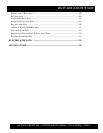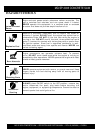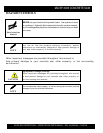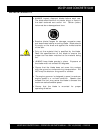
MQ SP-3035 CONCRETE SAW — OPERATION AND PARTS MANUAL — REV. #3 (09/29/06) — PAGE 2
MQ SP-3035 CONCRETE SAW
SILICOSIS /RESPIRATORY HAZARDS
Grinding/cutting/drillingofmasonry,concrete,metaland
other materials with silica in their composition may give
off dust or mists containing crystalline silica. Silica is a
basic componentofsand, quartz,brick clay,granite and
numerous other minerals and rocks. Repeated and/or
substantial inhalation of airborne crystalline silica can
cause serious or fatal respiratory diseases, including
silicosis. In addition, California and some other
authorities have listed respirable crystalline silica as a
substance known to cause cancer. When cutting such
materials, always follow the respiratory precautions
mentionedabove.
WARNING
Grinding/cutting/drillingofmasonry,concrete,metaland
other materials can generate dust, mists and fumes
containing chemicals known to cause serious or fatal
injury or illness, such as respiratory disease, cancer,
birth defects or other reproductive harm. If you are
unfamiliar with the risks associated with the particular
process and/or material being cut or the composition of
the tool being used, review the material safety data
sheet and/or consult your employer, the material
manufacturer/supplier, governmental agencies such as
OSHA and NIOSH and other sources on hazardous
materials. California and some other authorities, for
instance, have published lists of substances known to
cause cancer, reproductive toxicity, or other harmful
effects.
Control dust, mist and fumes at the source where
possible. In this regard use good work practices and
follow the recommendations of the manufacturers or
suppliers, OSHA/NIOSH, and occupational and trade
associations. Water should be used for dust
suppression when wet cutting is feasible. When the
hazardsfrom inhalationofdust,mists andfumescannot
be eliminated, the operator and any bystanders should
always weararespirator approvedby NIOSH/MSHAfor
thematerialsbeingused.
WARNING
SILICOSIS WARNING RESPIRATORY HAZARDS


















